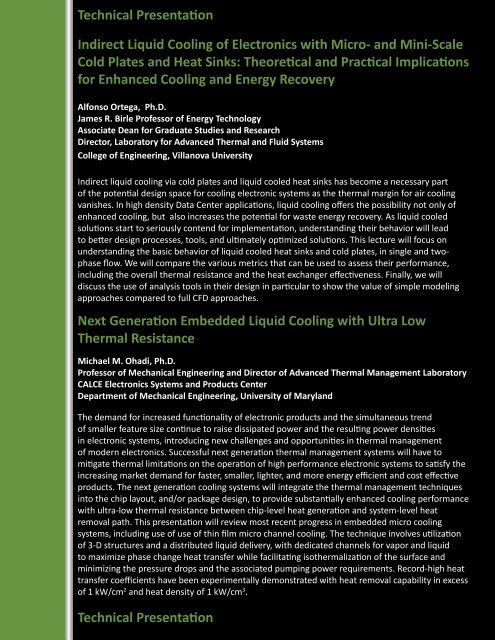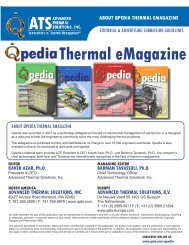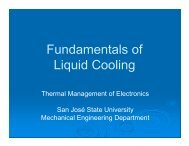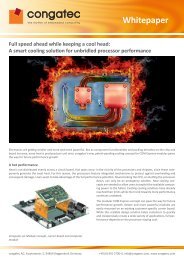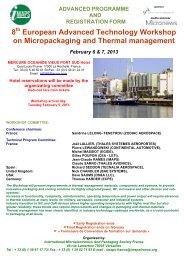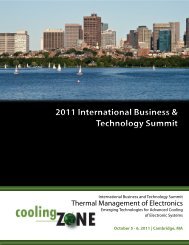coolingZONE-12 Thermal Management of Electronics eConference
coolingZONE-12 Thermal Management of Electronics eConference
coolingZONE-12 Thermal Management of Electronics eConference
You also want an ePaper? Increase the reach of your titles
YUMPU automatically turns print PDFs into web optimized ePapers that Google loves.
Technical Presentation<br />
Indirect Liquid Cooling <strong>of</strong> <strong>Electronics</strong> with Micro- and Mini-Scale<br />
Cold Plates and Heat Sinks: Theoretical and Practical Implications<br />
for Enhanced Cooling and Energy Recovery<br />
Alfonso Ortega, Ph.D.<br />
James R. Birle Pr<strong>of</strong>essor <strong>of</strong> Energy Technology<br />
Associate Dean for Graduate Studies and Research<br />
Director, Laboratory for Advanced <strong>Thermal</strong> and Fluid Systems<br />
College <strong>of</strong> Engineering, Villanova University<br />
Indirect liquid cooling via cold plates and liquid cooled heat sinks has become a necessary part<br />
<strong>of</strong> the potential design space for cooling electronic systems as the thermal margin for air cooling<br />
vanishes. In high density Data Center applications, liquid cooling <strong>of</strong>fers the possibility not only <strong>of</strong><br />
enhanced cooling, but also increases the potential for waste energy recovery. As liquid cooled<br />
solutions start to seriously contend for implementation, understanding their behavior will lead<br />
to better design processes, tools, and ultimately optimized solutions. This lecture will focus on<br />
understanding the basic behavior <strong>of</strong> liquid cooled heat sinks and cold plates, in single and twophase<br />
flow. We will compare the various metrics that can be used to assess their performance,<br />
including the overall thermal resistance and the heat exchanger effectiveness. Finally, we will<br />
discuss the use <strong>of</strong> analysis tools in their design in particular to show the value <strong>of</strong> simple modeling<br />
approaches compared to full CFD approaches.<br />
Next Generation Embedded Liquid Cooling with Ultra Low<br />
<strong>Thermal</strong> Resistance<br />
Michael M. Ohadi, Ph.D.<br />
Pr<strong>of</strong>essor <strong>of</strong> Mechanical Engineering and Director <strong>of</strong> Advanced <strong>Thermal</strong> <strong>Management</strong> Laboratory<br />
CALCE <strong>Electronics</strong> Systems and Products Center<br />
Department <strong>of</strong> Mechanical Engineering, University <strong>of</strong> Maryland<br />
The demand for increased functionality <strong>of</strong> electronic products and the simultaneous trend<br />
<strong>of</strong> smaller feature size continue to raise dissipated power and the resulting power densities<br />
in electronic systems, introducing new challenges and opportunities in thermal management<br />
<strong>of</strong> modern electronics. Successful next generation thermal management systems will have to<br />
mitigate thermal limitations on the operation <strong>of</strong> high performance electronic systems to satisfy the<br />
increasing market demand for faster, smaller, lighter, and more energy efficient and cost effective<br />
products. The next generation cooling systems will integrate the thermal management techniques<br />
into the chip layout, and/or package design, to provide substantially enhanced cooling performance<br />
with ultra-low thermal resistance between chip-level heat generation and system-level heat<br />
removal path. This presentation will review most recent progress in embedded micro cooling<br />
systems, including use <strong>of</strong> use <strong>of</strong> thin film micro channel cooling. The technique involves utilization<br />
<strong>of</strong> 3-D structures and a distributed liquid delivery, with dedicated channels for vapor and liquid<br />
to maximize phase change heat transfer while facilitating isothermalization <strong>of</strong> the surface and<br />
minimizing the pressure drops and the associated pumping power requirements. Record-high heat<br />
transfer coefficients have been experimentally demonstrated with heat removal capability in excess<br />
<strong>of</strong> 1 kW/cm 2 and heat density <strong>of</strong> 1 kW/cm 3 .<br />
Technical Presentation


